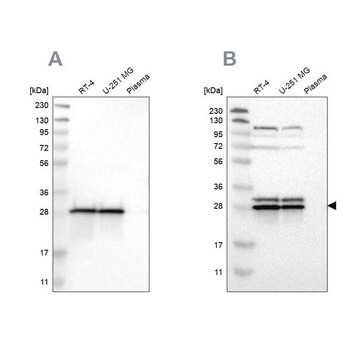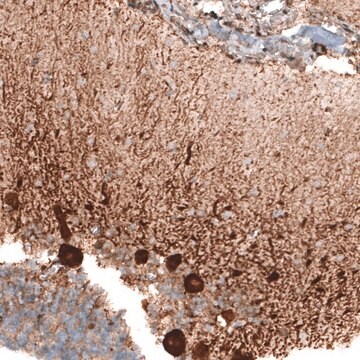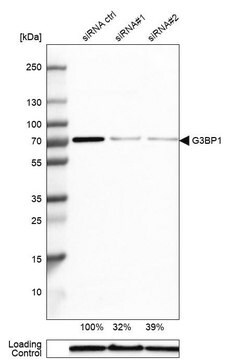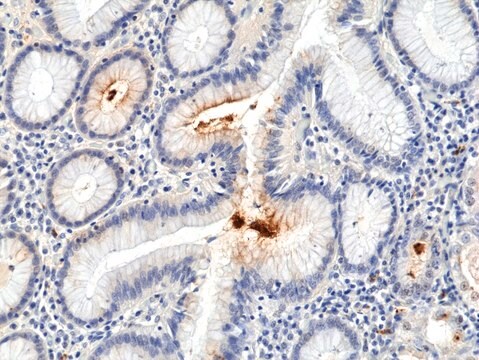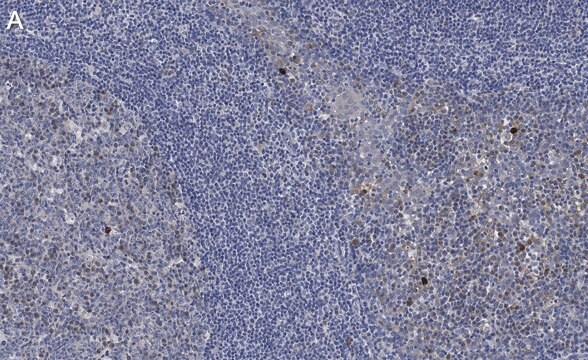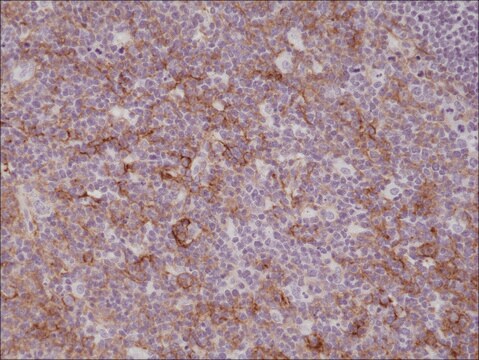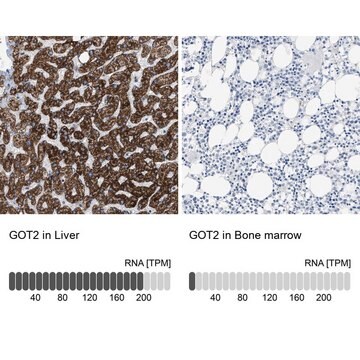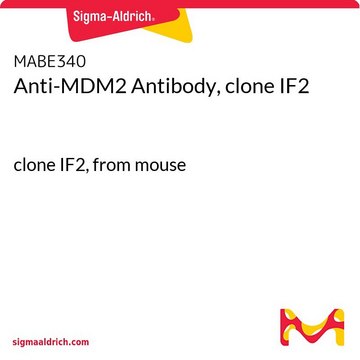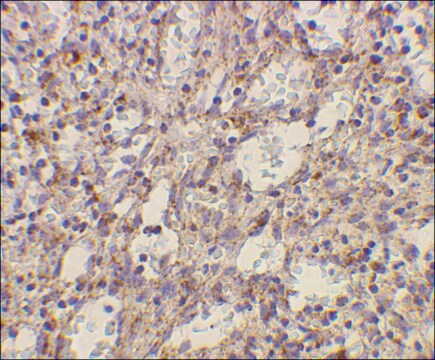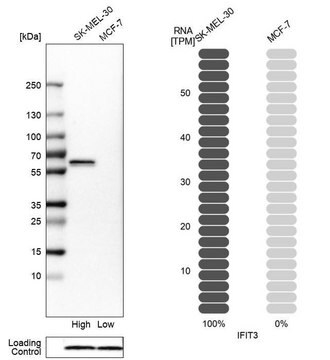推荐产品
生物源
rabbit
共軛
unconjugated
抗體表格
affinity isolated antibody
抗體產品種類
primary antibodies
無性繁殖
polyclonal
產品線
Prestige Antibodies® Powered by Atlas Antibodies
形狀
buffered aqueous glycerol solution
物種活性
mouse, human, rat
加強驗證
independent
Learn more about Antibody Enhanced Validation
技術
immunoblotting: 0.04-0.4 μg/mL
immunohistochemistry: 1:1000-1:2500
免疫原序列
ETIRTALAMGADRGIHVEVPPAEAERLGPLQVARVLAKLAEKEKVDLVLLGKQAIDDDCNQTGQMTAGFLDWPQGTFASQVTLEGDKLKVEREID
UniProt登錄號
運輸包裝
wet ice
儲存溫度
−20°C
目標翻譯後修改
unmodified
基因資訊
human ... ETFB(2109)
相关类别
一般說明
The gene electron transfer flavoprotein subunit β (ETFB) is mapped to human chromosome 19q13.3. The protein localizes in the mitochondria.
免疫原
Electron transfer flavoprotein subunit beta recombinant protein epitope signature tag (PrEST)
應用
All Prestige Antibodies Powered by Atlas Antibodies are developed and validated by the Human Protein Atlas (HPA) project and as a result, are supported by the most extensive characterization in the industry.
The Human Protein Atlas project can be subdivided into three efforts: Human Tissue Atlas, Cancer Atlas, and Human Cell Atlas. The antibodies that have been generated in support of the Tissue and Cancer Atlas projects have been tested by immunohistochemistry against hundreds of normal and disease tissues and through the recent efforts of the Human Cell Atlas project, many have been characterized by immunofluorescence to map the human proteome not only at the tissue level but now at the subcellular level. These images and the collection of this vast data set can be viewed on the Human Protein Atlas (HPA) site by clicking on the Image Gallery link. We also provide Prestige Antibodies® protocols and other useful information.
The Human Protein Atlas project can be subdivided into three efforts: Human Tissue Atlas, Cancer Atlas, and Human Cell Atlas. The antibodies that have been generated in support of the Tissue and Cancer Atlas projects have been tested by immunohistochemistry against hundreds of normal and disease tissues and through the recent efforts of the Human Cell Atlas project, many have been characterized by immunofluorescence to map the human proteome not only at the tissue level but now at the subcellular level. These images and the collection of this vast data set can be viewed on the Human Protein Atlas (HPA) site by clicking on the Image Gallery link. We also provide Prestige Antibodies® protocols and other useful information.
生化/生理作用
ETFB (electron transfer flavoprotein subunit β) is a subunit of electron transfer flavoprotein (ETF). ETF is responsible for transfer of electrons from primary flavoprotein dehydrogenases participating in mitochondrial fatty acid and amino acid catabolism to the membrane-associated electron transfer flavoprotein ubiquinone oxidoreductase. Mutations in ETFB results in blockage of the electron transfer from acyl-CoA dehydrogenases. This results in accumulation of various acyl-esters in blood and urine, causing multiple acyl-CoA dehydrogenation deficiency (MADD).
特點和優勢
Prestige Antibodies® are highly characterized and extensively validated antibodies with the added benefit of all available characterization data for each target being accessible via the Human Protein Atlas portal linked just below the product name at the top of this page. The uniqueness and low cross-reactivity of the Prestige Antibodies® to other proteins are due to a thorough selection of antigen regions, affinity purification, and stringent selection. Prestige antigen controls are available for every corresponding Prestige Antibody and can be found in the linkage section.
Every Prestige Antibody is tested in the following ways:
Every Prestige Antibody is tested in the following ways:
- IHC tissue array of 44 normal human tissues and 20 of the most common cancer type tissues.
- Protein array of 364 human recombinant protein fragments.
聯結
Corresponding Antigen APREST74685
外觀
Solution in phosphate-buffered saline, pH 7.2, containing 40% glycerol and 0.02% sodium azide
法律資訊
Prestige Antibodies is a registered trademark of Merck KGaA, Darmstadt, Germany
未找到合适的产品?
试试我们的产品选型工具.
儲存類別代碼
10 - Combustible liquids
水污染物質分類(WGK)
WGK 1
閃點(°F)
Not applicable
閃點(°C)
Not applicable
Jędrzej Małecki et al.
The Journal of biological chemistry, 290(1), 423-434 (2014-11-25)
Proteins are frequently modified by post-translational methylation of lysine residues, catalyzed by S-adenosylmethionine-dependent lysine methyltransferases (KMTs). Lysine methylation of histone proteins has been extensively studied, but it has recently become evident that methylation of non-histone proteins is also abundant and
Bárbara J Henriques et al.
The Journal of biological chemistry, 284(7), 4222-4229 (2008-12-18)
Mutations in the genes encoding the alpha-subunit and beta-subunit of the mitochondrial electron transfer flavoprotein (ETF) and the electron transfer flavoprotein:ubiquinone oxidoreductase (ETF:QO) cause multiple acyl-CoA dehydrogenation deficiency (MADD), a disorder of fatty acid and amino acid metabolism. Point mutations
Assignment of the gene encoding the beta-subunit of the electron-transfer flavoprotein (ETFB) to human chromosome 19q13.3.
R Antonacci et al.
Genomics, 19(1), 177-179 (1994-01-01)
Shigenari Hirokawa et al.
Journal of dermatological science, 64(2), 119-126 (2011-09-10)
Fibroblast activation is strongly influenced by mechanical environment in the wound-healing process, especially in fibrosis. Mechanically stressed three-dimensional collagen embedded culture is a useful model representing fibroblasts in morphological as well as biochemical situations encountered during fibrosis. To find key
Rikke K J Olsen et al.
Human mutation, 22(1), 12-23 (2003-06-20)
Mutations in electron transfer flavoprotein (ETF) and its dehydrogenase (ETFDH) are the molecular basis of multiple acyl-CoA dehydrogenation deficiency (MADD), an autosomal recessively inherited and clinically heterogeneous disease that has been divided into three clinical forms: a neonatal-onset form with
我们的科学家团队拥有各种研究领域经验,包括生命科学、材料科学、化学合成、色谱、分析及许多其他领域.
联系技术服务部门
